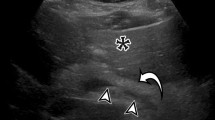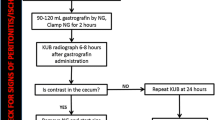Abstract
Human infestation with Ascaris lumbricoides is common in tropical and subtropical areas and is responsible for 20% of acute admissions annually to the surgical wards of the Red Cross Children's Hospital. Of the 225 children with symptomatic ascariasis seen during the 5-year period 1985–1989, 66% were intestinal, 30% hepato-biliary, and 4% pancreatic. Real-time ultrasound was the method of choice for diagnosis of invasion of the biliary and pancreatic systems. Eighty-four per cent resolved within 3 days after a short transient illness. Endoscopic retrograde cholangio-pancreatography was performed 15 times in 13 children when conservative measures failed and hepato-biliary infestation persisted. Complete removal of common bile duct worms was achieved in 55%. Thirty-seven (16%) were operated upon for deteriorating intestinal obstruction or persistent biliary and complicated hepatic disease. Indications for surgery are suspicion of ischaemic bowel, persistence of common bile duct worms for more than 4–6 weeks, liver disease, and persisting pseudocyst of the pancreas.
Similar content being viewed by others
References
Arean VM, Crandall CA (1971) Ascariasis. In: Marcial-Rojas PA (ed) Pathology and protozoal and helminthic diseases with clinical correlation. Williams and Wilkins Baltimore, p 769
Chang CC, Han CT (1966) Biliary ascariasis in childhood — a clinical analysis of 788 cases. Chinese Med J 85: 167–171
Cremin BJ (1982) Real time ultrasound in pediatric biliary ascariasis. Case reports. S Afr Med J 914–916
Cywes S, Krige H (1960) Intravenous cholangiography and tomography as an aid in the diagnosis of ascariasis of the biliary tract. S Afr Med J 34: 478–479
Gabaldon A, Mofidi C, Morishita K, Moskovskij S, Sankalé M, Standen DD (1967) Control of ascariasis (report of a WHO expert committee). World health organization technical report series 379: 6–7
Kamath PS, Joseph DC, Chandran R, Rao SR, Prakash ML, D'Cruz A (1986) Biliary ascariasis: ultrasonography, endoscopic retrograde cholangiopancreatography, and biliary drainage. Gastroenterology 91: 730–732
Khuroo MS, Zargar SA (1985) Biliary Ascariasis. A common cause of biliary and pancreatic disease in an endemic area. Gastroenterology 88: 418–423
Leung JWC, Mok SD, Metreweli C (1987) Ascaris-induced pancreatitis. AJR 149: 511–512
Lloyd DA (1981) Massive hepatobiliary ascariasis in childhood. Br J Surg 68: 468–473
Lloyd DA (1982) Hepatic ascariasis. S Afr J Surg 20: 297–304
Louw JH (1974) Biliary ascariasis in childhood. S Afr J Surg 12: 219–225
Louw JH (1981) Abdominal complications of ascariasis. Surgical Rounds 4: 54–65
Louw JH, Rode H (1987) Ascariasis. In: Way LW, Pellegrini CA (eds) Surgery of the gallbladder and bile ducts. Saunders, Philadelphia, pp 539–555
Millar AJW, Rode H, Stunden RJ, Cywes S (1988) Management of pancreatic pseudocysts in children. J Ped Surg 23: 122–127
Mokoena T, Luvuno FM (1988) Conservative management of intestinal obstruction due to ascaris worms in adult patients: a preliminary report. J R Coll Surg Edinb 33: 318–321
Monroe LS (1985) Gastrointestinal parasites. In: Berk JW (ed) bockus gastroenterology. Saunders, Philadelphia, p 4250
Moore S, Millar AJW, Cywes S (1988) Liver abscess in childhood. Pediatr Surg Int 3: 27–32
Pillay SP, Baker LW, Angorn IB (1978) Ascaris lumbricoides producing obstructive jaundice. JR Coll Surg Edinb 23: 25–29
Schulman A, Loxton AJ, Heydenrych JJ, Abdurahman KE (1982) Sonographic diagnosis of biliary ascariasis. AJR 139: 485–489
Spicer RD, Cywes S (1988) Pancreatitis in childhood. Pediatr Surg Int 3: 33–36
Van der Spuy S (1978) Biliary ascariasis — endoscopic aspects. S Afr Med J 53: 1030–1033
Wardhan H, Gangopadhyay AN, Gopal SC, Singhal GD (1989) Ascaris lumbricoides causing intestinal obstruction in children — a review of 33 cases. Pediatr Surg Int 4: 88–89
Wiersma R, Hadley GP (1988) Small bowel volvulus complicating intestinal ascariasis in children. Br J Surg 75: 86–87
Witcombe JB, Cremin BJ (1978) The width of the common bile duct in childhood. Pediat Radiol 7: 147–149
Author information
Authors and Affiliations
Additional information
Offprint requests to: H. Rode
Rights and permissions
About this article
Cite this article
Rode, H., Cullis, S., Millar, A. et al. Abdominal complications of Ascaris lumbricoides in children. Pediatr Surg Int 5, 397–401 (1990). https://doi.org/10.1007/BF00174333
Issue Date:
DOI: https://doi.org/10.1007/BF00174333




